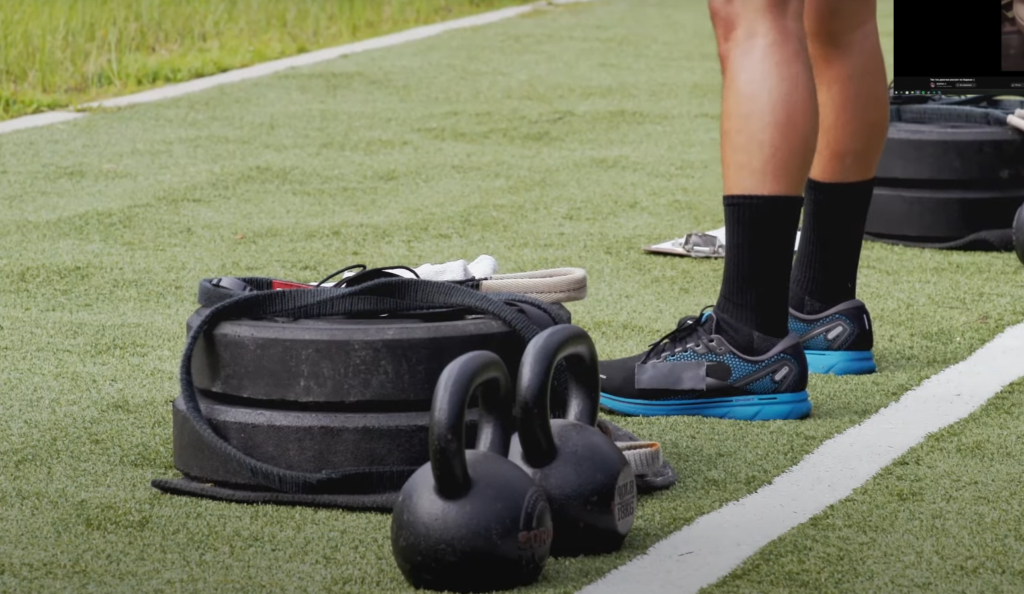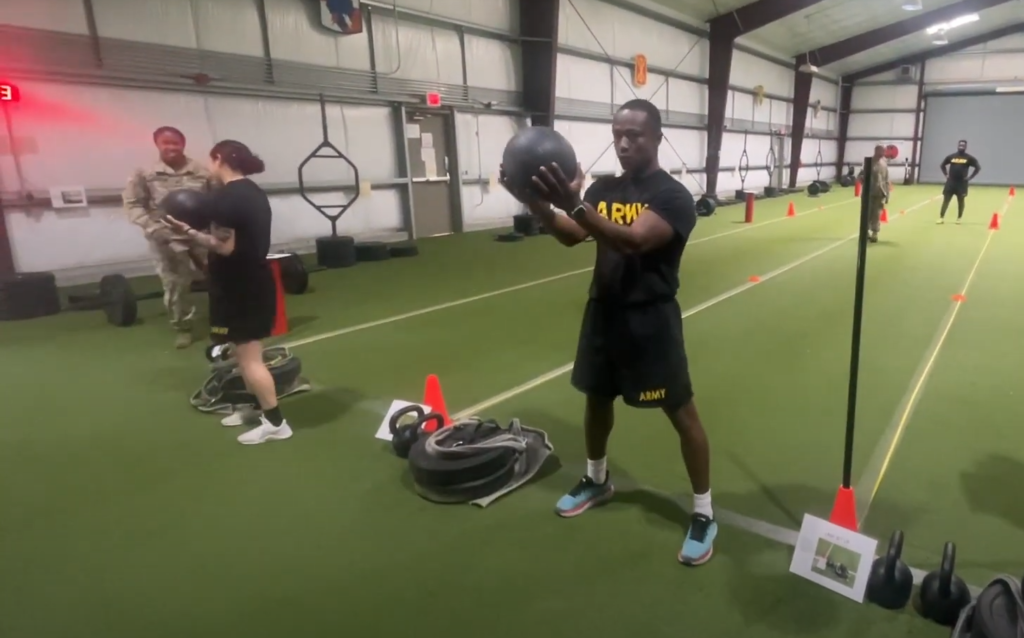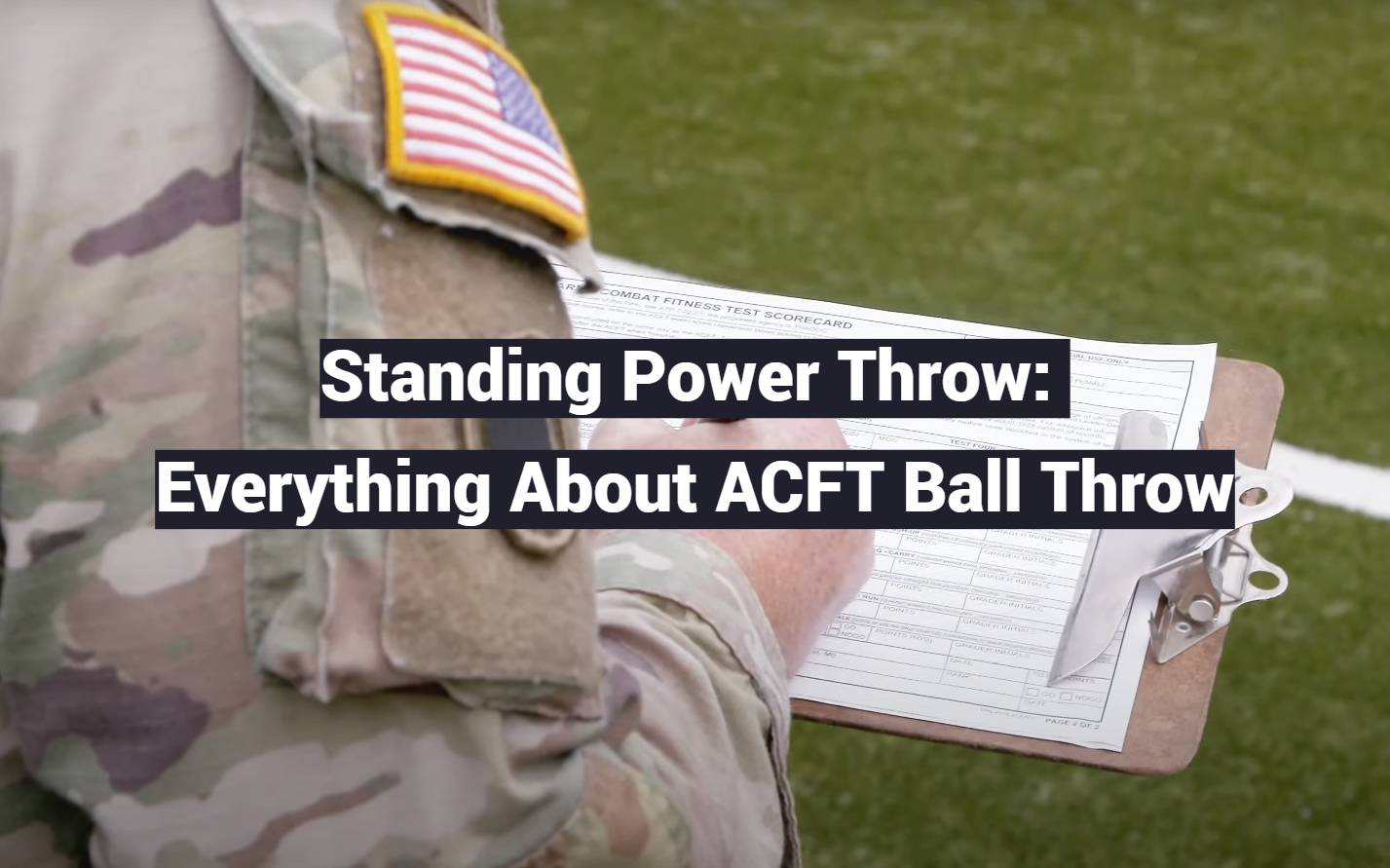Unlocking the dynamics of the Army Combat Fitness Test (ACFT), the Standing Power Throw emerges as a pivotal event, assessing soldiers’ explosive strength and coordination. In this comprehensive guide, we delve into the nuances of the Standing Power Throw, providing an in-depth exploration of its significance, rules, and training strategies.
From understanding the optimal throwing form to decoding the scoring standards, this article equips individuals with the knowledge needed to excel in the ACFT Ball Throw. Join us on a journey through the intricacies of this challenging event, arming you with insights to conquer the Standing Power Throw with confidence.
What Is The Standing Power Throw (SPT) As an ACFT Event?
[tds_note]The Standing Power Throw (SPT) is a dynamic and challenging event that has been incorporated into the Army Combat Fitness Test (ACFT), replacing the traditional throw of the hand grenade [1]. Introduced to better assess soldiers’ explosive power, the Standing Power Throw evaluates an individual’s ability to generate force and project an object over a distance. As a significant component of the ACFT, the SPT aims to measure upper and lower body strength, coordination, and overall power.[/tds_note]
In the Standing Power Throw, participants stand with both feet shoulder-width apart, holding a 10-pound medicine ball. The objective is to throw the ball backward over the head, covering as much distance as possible. The measurement is taken from the starting point to where the ball first makes contact with the ground. Soldiers have two attempts to achieve the longest throw possible.
This event reflects the Army’s commitment to assessing functional fitness that translates directly to the physical demands of combat situations. Explosive power is crucial in various military scenarios, such as obstacle clearance, evasive maneuvers, and lifting and carrying heavy objects. The Standing Power Throw provides a reliable metric to gauge a soldier’s ability to generate force and project objects quickly, mirroring the demands of real-world combat situations.

To excel in the SPT, soldiers need a combination of strength, speed, and technique. Proper body mechanics, including a strong hip and leg drive, are essential for generating the necessary force to propel the medicine ball. Additionally, the coordination between the upper and lower body is crucial to maximize the throwing distance.
Training for the Standing Power Throw involves a focus on explosive exercises, such as power cleans, kettlebell swings, and plyometric drills. These workouts help enhance the fast-twitch muscle fibers responsible for explosive movements. Soldiers also benefit from improving overall strength and flexibility, which contribute to the efficiency of the throwing motion.
The Standing Power Throw, as part of the ACFT, aligns with the Army’s commitment to developing well-rounded and physically resilient soldiers. It not only provides an accurate assessment of a soldier’s explosive power but also encourages individuals to incorporate a diverse range of exercises into their training regimen.
As the military landscape evolves, the ACFT continues to be refined to ensure it reflects the physical capabilities required for success in the modern battlefield. The Standing Power Throw stands as a testament to the Army’s dedication to maintaining a high standard of fitness and readiness among its personnel.
4 Key Components to the Standing Power Throw:
1. Grip:
The grip plays a fundamental role in the success of the Standing Power Throw (SPT). Soldiers are required to hold a 10-pound medicine ball while executing the throw. A proper grip ensures control and stability during the motion, preventing the ball from slipping or shifting unexpectedly. Soldiers should aim for a firm yet comfortable grip, distributing the weight evenly across their hands. The grip becomes especially crucial as it sets the foundation for the subsequent explosive movements involving the arms and legs [2].
2. Arms:
The arms act as the primary drivers in the Standing Power Throw, orchestrating the explosive release of the medicine ball. Proper technique involves a quick and powerful extension of the arms, generating maximum force to propel the ball backward. Soldiers should focus on engaging the muscles in their shoulders, triceps, and forearms during the throwing motion. The coordination between the grip and the arms is essential to harness the energy efficiently and transfer it to the ball.
3. Legs:
The lower body, particularly the legs, is a powerhouse in the Standing Power Throw. A strong and coordinated leg drive is essential for generating the explosive force required to launch the medicine ball over a significant distance. Soldiers should initiate the throw by bending their knees and loading their lower body with energy. The subsequent extension of the hips and legs is what propels the ball forward. Strengthening the muscles in the legs through targeted exercises like squats and lunges contributes significantly to a powerful throw.
4. Coordination:
Coordination is the glue that binds the grip, arms, and legs together in a seamless motion during the Standing Power Throw. Achieving an optimal throw requires precise timing and synchronization of these components. Soldiers must coordinate the release of the ball with the extension of their arms and legs, ensuring that each element contributes to the overall power and accuracy of the throw. Developing a sense of rhythm and timing through practice is crucial to refining coordination and achieving peak performance in the Standing Power Throw.
[tds_note]Mastering these four key components – grip, arms, legs, and coordination – is essential for soldiers aiming to excel in the Standing Power Throw event of the Army Combat Fitness Test (ACFT). A holistic approach to training, encompassing strength, technique, and timing, will empower individuals to harness their explosive power effectively and achieve optimal results in this dynamic assessment.[/tds_note]

SPT Test Instructions And Techniques
Here are the instructions and techniques for the Standing Power Throw (SPT) test, often included in fitness assessments like the Army Combat Fitness Test (ACFT):
Equipment:
- 10-pound medicine ball;
- Measuring tape;
- Flat, clear throwing lane [3];
Instructions:
Starting Position:
- Stand with your heels at the starting line, facing away from the direction of the throw;
- Grasp the medicine ball firmly with both hands at hip level;
- Keep your feet shoulder-width apart;
Preparatory Movements:
- Flex your knees, hips, and trunk slightly, lowering the ball between your legs;
- Keep your back straight and avoid rounding your shoulders;
- Repeat these movements a few times to generate momentum;
Throw:
- Explode upward and forward, extending your hips, knees, and ankles forcefully;
- Simultaneously swing the medicine ball upward and overhead in a continuous arc;
- Release the ball at an angle of approximately 45 degrees;
- Aim for maximum distance, not height;
Scoring:
- The distance of the throw is measured from the starting line to the point where the ball first touches the ground;
- You are allowed two record attempts;
- The farthest throw counts as your score;
Technique Tips:
- Use your legs: Generate power from your lower body, not just your arms;
- Engage your core: Keep your core muscles tight to transfer energy efficiently;
- Follow through: Extend your arms fully and release the ball with force;
- Practice: Repetition is key to improving your technique and distance;
Common Faults:
- Stepping on or over the starting line;
- Falling to the ground during the throw;
- Releasing the ball before reaching full extension;
- Using only arm strength to throw the ball;
Additional Notes:
- Warm up properly before attempting the SPT;
- If you have any injuries or concerns, consult with a healthcare professional before performing the test;
- Proper hydration and nutrition are important for optimal performance;

Standing Power Throw Standards For the ACFT
For the Standing Power Throw, soldiers were required to throw a 10-pound medicine ball as far as possible behind them. The distance achieved determined the score, and different score ranges were assigned based on gender and age groups. Here is a general overview:
ACFT Standing Power Throw Standards:
Men:
- Ages 17-21: A throw of 4.5 meters or more is considered a minimum passing score, with a maximum score achieved by a throw of 13.5 meters or more;
- Ages 22-26: Minimum passing score at 4.5 meters, maximum score at 13.5 meters or more;
- Ages 27-31: Minimum passing score at 4.5 meters, maximum score at 13.5 meters or more [4];
Women:
- Ages 17-21: Minimum passing score at 3.5 meters, maximum score at 9.5 meters or more;
- Ages 22-26: Minimum passing score at 3.5 meters, maximum score at 9.5 meters or more;
- Ages 27-31: Minimum passing score at 3.5 meters, maximum score at 9.5 meters or more;
The scoring system emphasizes both the power and accuracy of the throw, with soldiers aiming to achieve the farthest distance possible within the specified throwing area.
It’s crucial to note that these standards are subject to change, and the Army periodically reviews and updates its fitness standards. Soldiers are encouraged to stay informed about the latest ACFT requirements through official Army publications or by consulting their unit’s fitness coordinators. Additionally, specific guidance may be provided based on individual factors such as job requirements and deployment status.
How Can You Prepare For The Standing Power Throw Test?
Preparing for the Standing Power Throw (SPT) test in the Army Combat Fitness Test (ACFT) requires a combination of strength training, explosive power development, and refining throwing technique.
Here are some effective strategies to help you prepare for the SPT:
Strength Training:
- Focus on compound movements that engage multiple muscle groups, such as squats, deadlifts, and bench presses. These exercises build overall strength, including the muscles involved in the Standing Power Throw;
- Include specific exercises that target the muscles used in the SPT, such as medicine ball slams, kettlebell swings, and overhead presses [5];
Explosive Power Exercises:
- Plyometric exercises are crucial for developing explosive power. Incorporate box jumps, jump squats, and power cleans into your routine to enhance your ability to generate force quickly;
- Medicine ball throws and slams can simulate the throwing motion of the SPT and help improve your explosive power;
Throwing Technique Practice:
- Work on your throwing technique regularly. Practice the SPT motion with a medicine ball to refine your coordination and timing;
- Focus on the proper sequence of movements, starting from the legs, transferring through the hips and torso, and finishing with a powerful extension of the arms;
Core Strengthening:
- A strong core is essential for stability and power transfer during the throw. Include exercises like planks, Russian twists, and leg raises to strengthen your core muscles;
- Stability exercises, such as single-leg exercises, can improve balance and control, contributing to a more effective throw;

Flexibility and Mobility:
- Maintain good flexibility in your hips, shoulders, and thoracic spine. Adequate mobility is essential for a smooth and efficient throwing motion;
- Incorporate dynamic stretches and mobility exercises into your warm-up routine to enhance flexibility and reduce the risk of injury;
Interval Training:
- Improve your cardiovascular fitness and endurance with high-intensity interval training (HIIT). This will help you maintain energy levels throughout the ACFT;
- Include sprints, rowing, or cycling intervals to simulate the bursts of effort required in the SPT;
Practice Under Test Conditions:
- Familiarize yourself with the SPT setup and practice the throw under conditions similar to the actual test. This includes using a regulation-weight medicine ball and adhering to the specific testing guidelines;
- Mimic the timing and intensity of the test during your training sessions to build familiarity and confidence;
Remember to progressively increase the intensity and volume of your training to avoid overtraining and reduce the risk of injury. Additionally, stay well-hydrated, get adequate rest, and consider consulting with a fitness professional or your unit’s fitness coordinator for personalized guidance based on your individual needs and goals.
Workouts to Improve the Standing Power Throw for the ACFT:
1. Kettlebell Swings:
How to Perform:
- Stand with your feet shoulder-width apart, holding a kettlebell with both hands between your legs;
- Hinge at your hips, keeping a slight bend in your knees, and swing the kettlebell forward by driving your hips forward and extending your knees;
- Swing the kettlebell to shoulder height, maintaining a straight line from your head to your heels;
- Control the descent and repeat the movement for the desired number of reps [6];
Benefits:
- Kettlebell swings target the hip hinge movement, engaging the posterior chain muscles that are crucial for explosive power;
- This exercise helps improve the coordination between your hips and upper body, similar to the Standing Power Throw;
2. Barbell Push Press:
How to Perform:
- Start with a barbell at shoulder height, feet shoulder-width apart;
- Bend your knees slightly and explosively push the barbell overhead using your legs and hips;
- Finish with arms fully extended overhead;
- Lower the barbell back to shoulder height and repeat;
Benefits:
- The push press targets the upper body, particularly the shoulders, triceps, and core;
- This exercise helps build explosive strength and power, essential for the force generation in the Standing Power Throw;
3. Standing Power Throw Progression:
How to Perform:
- Start without a medicine ball, focusing on the mechanics of the throw;
- Stand with feet shoulder-width apart and simulate the throwing motion by extending your hips, torso, and arms explosively;
- Practice the coordination between your grip, arms, and legs, paying attention to the sequential engagement of these components;
- Gradually introduce a light medicine ball and progress to the regulation weight as your strength and technique improve;
Benefits:
- The specific practice of the Standing Power Throw motion allows you to refine your technique and improve coordination;
- Breaking down the movement into progressions helps in mastering each component before incorporating them into the full throw;

The ACFT Standing Power Throw Training Tips
Consistency is Key:
Incorporate these exercises into your regular training routine, aiming for at least two to three sessions per week.
Gradual Progression:
Start with lighter weights and fewer repetitions, gradually increasing intensity as your strength and technique improve [7].
Focus on Technique:
Emphasize proper form in each exercise to maximize the effectiveness of the movement and reduce the risk of injury.
Include Recovery Days:
Allow your body sufficient time to recover between intense workouts. Adequate rest is essential for performance improvement and injury prevention.
Warm-up Thoroughly:
Prioritize a dynamic warm-up that targets the muscles involved in the Standing Power Throw to enhance flexibility and prepare your body for explosive movements.
Consult with a Fitness Professional:
If possible, seek guidance from a fitness professional or your unit’s fitness coordinator to ensure that your training plan aligns with your specific needs and goals.
By integrating these workouts into your training regimen and focusing on consistent, targeted practice, you can enhance your strength, explosive power, and overall performance in the Standing Power Throw for the ACFT.
Trouble Spots On the SPT
[tds_warning]The Standing Power Throw (SPT) in the Army Combat Fitness Test (ACFT) can present challenges for some individuals. Identifying potential trouble spots and addressing them through targeted training can contribute to improved performance.[/tds_warning]

Here are some common trouble spots on the SPT and strategies to overcome them:
1. Lack of Explosive Power:
Issue: Insufficient explosive power can limit the throwing distance;
Solution:
- Focus on plyometric exercises like box jumps, jump squats, and medicine ball throws to enhance explosive power;
- Incorporate power cleans and snatches into your strength training routine to improve fast-twitch muscle activation [8];
2. Poor Coordination:
Issue: Difficulty coordinating the movement of the legs, hips, and arms can lead to a less effective throw.
Solution:
- Practice the throwing motion without a medicine ball to concentrate on proper coordination;
- Include drills that isolate each component (legs, hips, arms) to improve the timing and synchronization of the movement;
3. Ineffective Grip:
Issue: A weak or improper grip may result in loss of control during the throw.
Solution:
- Strengthen grip with exercises like farmer’s walks, hanging from a bar, and using grip trainers;
- Ensure a firm yet comfortable grip on the medicine ball during practice to build confidence and control;
4. Insufficient Core Stability:
Issue: Weakness in the core can impact stability and power transfer during the throw.
Solution:
- Incorporate core-strengthening exercises such as planks, Russian twists, and rotational medicine ball throws;
- Include stability exercises like single-leg exercises to improve balance and control;
5. Limited Hip Mobility:
Issue: Restricted hip mobility can hinder the ability to generate power from the lower body.
Solution:
- Include dynamic hip stretches and mobility drills in your warm-up routine;
- Practice exercises like deep squats and lunges to enhance hip flexibility and range of motion;
6. Incorrect Body Positioning:
Issue: Incorrect alignment during the throw can lead to suboptimal results.
Solution:
- Ensure proper body positioning with feet shoulder-width apart and weight distributed evenly;
- Record and review your throws to identify any deviations from the correct form;
7. Overemphasis on Arm Strength:
Issue: Relying too much on arm strength may limit the overall power generated in the throw.
Solution:
- Emphasize the role of the lower body in generating power;
- Practice integrating a strong leg drive into the throwing motion to maximize force;
8. Inadequate Practice:
Issue: Lack of regular practice can result in a lack of familiarity with the throwing motion.
Solution:
- Include dedicated SPT practice sessions in your training routine;
- Simulate test conditions during practice to build confidence and consistency;
Addressing these trouble spots through targeted training and focused practice can improve performance in the Standing Power Throw, helping you meet or exceed the ACFT standards. Consider consulting with a fitness professional or your unit’s fitness coordinator for personalized guidance based on your specific challenges and goals [9].

FAQ:
1. How do you improve your ACFT standing power throw?
Focus on exercises that enhance explosive power and strength, including plyometrics, power cleans, and kettlebell swings. Regularly practice the standing power throw motion to refine coordination and technique.
2. How heavy is the ball for the ACFT power throw?
The medicine ball used for the ACFT power throw weighs 10 pounds.
3. Can you jump on the standing power throw?
No, jumping is not allowed. The standing power throw requires a stationary stance, utilizing explosive power from the legs and hips.
4. What are the rules for the ACFT power throw?
Participants stand with feet shoulder-width apart and throw a 10-pound medicine ball backward over the head for maximum distance. The measurement is from the starting point to where the ball first contacts the ground.
5. What is the best form for a standing power throw?
The best form involves proper coordination between the grip, arms, and legs. Emphasize a strong leg drive, hip extension, and an explosive release of the ball.
6. What is the male minimum for standing power throw?
The minimum passing score for males in the Standing Power Throw is 4.5 meters.
7. What is a good ACFT score?
A good ACFT score depends on factors such as age and gender. Check the official ACFT scoring chart for specific score ranges.
8. What muscles does the standing power throw use?
The standing power throw engages muscles in the legs, hips, core, shoulders, and arms.
9. How do you get a better ball throw?
Improve overall strength and explosive power through targeted exercises. Practice the throwing motion regularly, focusing on technique and coordination.
10. How many practice throws do you get for the standing power throw?
The number of practice throws may vary, and it is advisable to check with the event facilitators. Typically, participants are allowed a brief warm-up.
11. How heavy is the standing power throw?
The standing power throw involves throwing a 10-pound medicine ball.
12. Can you fail an ACFT event?
Yes, it is possible to fail individual ACFT events. The overall ACFT score determines overall test results.
13. Can I wear gloves for ACFT?
Yes, you are allowed to wear gloves during the ACFT. Ensure they comply with military uniform regulations.
14. What happens if you don’t pass the ACFT in basic training?
Failure to pass the ACFT may lead to remedial training or retesting. The consequences can vary based on individual circumstances.
15. Who can grade an ACFT?
Trained graders, typically certified by the Army, are authorized to grade the ACFT.
16. How can you throw a ball farther?
Focus on improving explosive power, proper technique, and coordination. Strengthening the legs and core will contribute to a more powerful throw.
17. Is throwing a ball muscular strength?
Yes, throwing a ball involves the use of muscular strength, particularly in the legs, hips, and upper body.
18. What size is the medicine ball for the ACFT?
The regulation medicine ball for the ACFT power throw weighs 10 pounds.
19. What are the 3 mandatory ACFT events?
The three mandatory ACFT events are the Deadlift, Standing Power Throw, and the Two-Mile Run. These events are required for a valid ACFT score.
Useful Video: Top 5 Tips for ACFT Standing Power Throw- SPT
References:
- https://www.army.mil/acft/
- https://www.dummies.com/article/academics-the-arts/study-skills-test-prep/armed-services/acft-event-standing-power-throw-283765/
- https://www.operationmilitarykids.org/standing-power-throw-acft/
- https://www.gpshumanperformance.com/tactical-training-the-acft-standing-power-throw/
- https://www.armycombatfitnesstest.com/post/powerthrowtraining
- https://www.reddit.com/r/army/comments/sl9tmk/how_to_get_good_at_the_standing_power_throw/
- https://www.army-fitness.com/acft-events-parent/standing-power-throw/
- https://malcolmcarlyle.com/2022/12/11/the-standing-power-throw/
- https://sfnationalguard.com/6-workouts-to-max-the-army-acft/






Leave a Reply